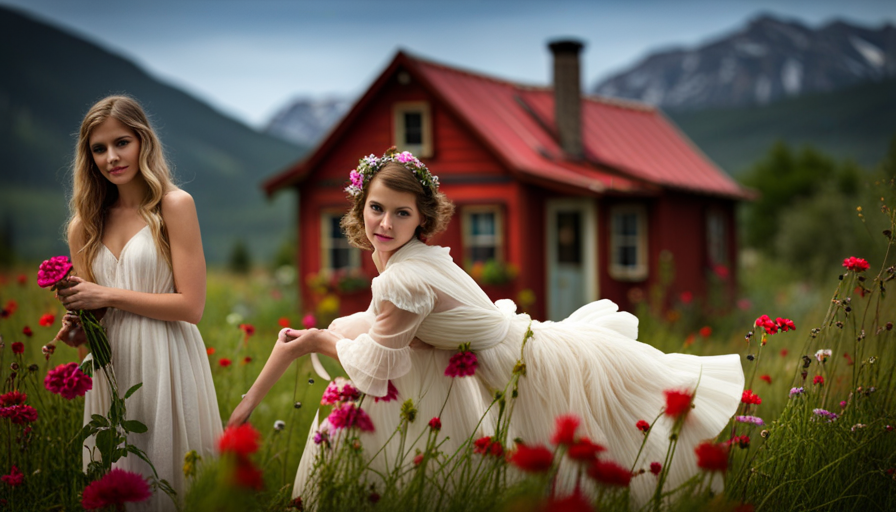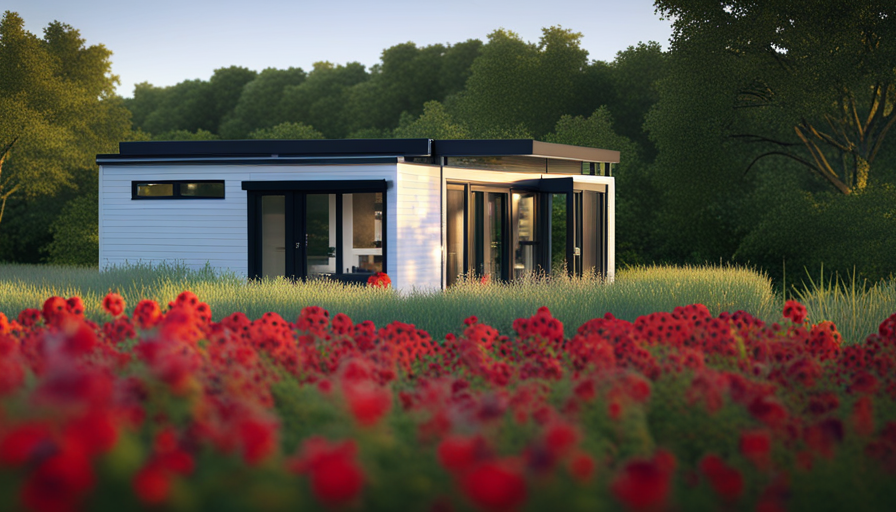In a society that often prioritizes simplicity, I am intrigued by the contrasting lifestyles of two siblings. While one sister shines as a successful model, gracing magazine covers and runway shows with ease, the other has chosen a less conventional path, living in a small home that challenges traditional notions of space and possessions.
These two worlds collide, creating a fascinating juxtaposition of fashion and minimalism. As I delve into their stories, I am drawn to the concept of minimalism in fashion and the rise of tiny houses as a lifestyle choice. Through their unique journeys, they redefine success in the fashion industry and inspire others to embrace a simpler way of life.
Join me as we explore the power of collaboration between fashion and home design, and unravel the future of these two seemingly unrelated worlds. Let’s dive into this captivating tale of two sisters, each carving their own path towards fulfillment and self-discovery.
Key Takeaways
- Contrasting lives of two sisters: one a successful model, the other living in a tiny house
- Fashion and minimalism collide in their stories
- Tiny houses gaining popularity as an alternative to traditional housing
- Collaboration between fashion and architecture promotes sustainable living
Exploring Minimalism in Fashion
Let’s dive into the world of minimalism in fashion and discover how it can transform your wardrobe! Minimalism isn’t just about owning fewer clothes, but also about adopting a mindset that values quality over quantity.
By embracing minimalism in everyday life, you can simplify your wardrobe and create a more streamlined and functional collection of clothing. This can have a positive impact on your mental well-being, as studies have shown that clutter and excess can contribute to feelings of stress and overwhelm.
By curating a minimalist wardrobe, you can reduce decision fatigue, increase your confidence, and save time and money.
Now, let’s transition to the subsequent section about the rise of tiny houses and how they’re changing the way we live.
The Rise of Tiny Houses
Explore the growing popularity of compact dwellings, and evaluate whether the trend of tiny houses is truly on the rise. Tiny houses have gained significant attention in recent years, as more people are embracing minimalistic lifestyles and seeking alternatives to traditional housing. These small, efficient homes offer a range of benefits, including lower costs, reduced environmental impact, and the opportunity to live a simpler, clutter-free life. To better understand the rise of tiny houses, let’s examine their key features in comparison to fashion minimalism:
| Tiny Houses | Fashion Minimalism |
|---|---|
| Small size and efficient design | Capsule wardrobes and timeless pieces |
| Emphasis on sustainability and eco-friendliness | Preference for sustainable and ethically produced clothing |
| Focus on functionality and multi-purpose use | Prioritization of versatile and practical clothing |
As the demand for smaller, more sustainable living options continues to grow, the popularity of tiny houses is expected to rise. Transitioning seamlessly into the next section about ‘sisters in different worlds,’ we can see how these two trends intersect in the lives of our main characters.
Sisters in Different Worlds
In discussing the subtopic of Sisters in Different Worlds, we will explore the contrasting careers of fashion and architecture that my sister and I have pursued.
While she’s found success in the fashion industry, I’ve chosen a path in architecture. Despite our differing paths, we’ve found common ground in our shared love for minimalism. This love has inspired both of our creative journeys.
Through our unique careers, we’ve been able to inspire and support each other in our respective fields. We’re constantly pushing each other to reach new heights.
Contrasting Careers in Fashion and Architecture
Imagine yourself in the world of fashion, where glamorous runways and high-end designers reign supreme, while your sister is in the world of architecture, creating innovative and sustainable tiny homes that redefine the concept of living – two contrasting careers that ignite passion and provoke thought.
In architecture, minimalism is a key trend, focusing on simplicity, clean lines, and functional spaces. Similarly, in the fashion industry, sustainable fashion trends are gaining popularity, emphasizing minimalism in design and production processes.
Both fields share a common goal of promoting sustainable practices and reducing waste. While fashion and architecture may seem worlds apart, they find common ground in minimalism, seeking to create spaces and designs that are environmentally friendly and visually appealing.
This shared value of minimalism bridges the gap between the two industries, fostering collaboration and inspiring innovative approaches to design.
Finding Common Ground in Minimalism
Embrace the simplicity and clean lines of minimalism, and discover the common ground between fashion and architecture.
Minimalism in home decor has gained popularity for its ability to create a calm and clutter-free environment. By simplifying our living spaces, we can experience numerous benefits. Firstly, minimalism promotes a sense of tranquility and mindfulness by reducing visual distractions.
Secondly, it allows us to focus on what truly matters, fostering a sense of clarity and peace. Additionally, minimalism encourages sustainability and conscious consumption, as it promotes the use of natural and eco-friendly materials.
Fashion and architecture can both draw inspiration from these principles, as they emphasize clean lines, functionality, and timeless design. By embracing minimalism, we can find a shared appreciation for simplicity and inspire each other’s creative journeys, exploring new possibilities for self-expression.
Inspiring Each Other’s Creative Journeys
Discover the endless possibilities of creativity by inspiring each other’s journeys in fashion and architecture. When a girl model with a passion for fashion collaborates with her sister who has a tiny house, they create a unique synergy that explores artistic expression in both fields. They support each other’s dreams by sharing ideas, materials, and techniques, allowing their respective passions to flourish.
Fashion meets architecture: By combining their expertise, they blur the lines between these two artistic realms, creating innovative designs that challenge traditional boundaries.
Sustainable fashion and tiny house living: They both prioritize sustainability, using eco-friendly materials and practices in their work. Their collaboration encourages others to consider the environmental impact of their choices.
Cross-pollination of ideas: By sharing their experiences and knowledge, they push each other to think outside the box and find new ways to express their creativity.
By exploring artistic expression and supporting each other’s dreams, they redefine success in the fashion industry by breaking away from conventional norms and embracing a more holistic approach.
Redefining Success in the Fashion Industry
Redefining success in the fashion industry means breaking free from conventional norms and embracing diversity and authenticity. In a world that’s long perpetuated unattainable beauty standards, the fashion industry is slowly shifting towards a more inclusive and sustainable approach.
Sustainable fashion, which focuses on reducing the environmental impact of clothing production, is gaining traction as more designers and consumers recognize the need for change. Moreover, redefining beauty standards is also becoming a prominent movement within the industry. Models of different sizes, ages, and ethnicities are being celebrated for their uniqueness and individuality. This shift not only promotes body positivity but also allows for a wider representation of people in the fashion world.
By embracing these changes, the fashion industry is not only redefining success but also inspiring others to do the same. Transitioning into the next section about "the power of collaboration," it’s evident that these shifts in the fashion industry are not happening in isolation but rather through collective efforts and creative partnerships.
The Power of Collaboration
Combining fashion and architecture in creative projects allows for the exploration of innovative and boundary-breaking ideas. By merging the disciplines of fashion and architecture, new possibilities arise that can inspire fresh perspectives and approaches.
Collaborating with experts from both fields can leverage each other’s expertise, leading to innovative solutions that push the boundaries of what’s considered possible in the fashion industry.
Combining Fashion and Architecture in Creative Projects
When it comes to blending fashion and architecture, creative projects offer endless opportunities for collaboration and innovation.
Exploring architectural fashion collaborations allows designers to combine their unique perspectives and expertise to create stunning and functional pieces.
Fashion has a significant influence on tiny house design, as it brings elements of style, functionality, and sustainability to these compact living spaces.
Incorporating fashion into the design of tiny houses allows for the creation of aesthetically pleasing and personalized spaces that reflect the individual’s sense of style.
By integrating fashion and architecture, designers can break boundaries and inspire new ideas that push the limits of creativity.
This collaboration between fashion and architecture opens up a world of possibilities, encouraging designers to think outside the box and create innovative designs that redefine the way we live and interact with our living spaces.
Breaking Boundaries and Inspiring New Ideas
Combining fashion with architecture has always been a captivating endeavor, pushing the boundaries of creativity and inspiring new ideas. However, there is a growing movement that takes this fusion to a whole new level, exploring unconventional fashion while promoting sustainable living.
This movement has given rise to unique collaborations, one of which involves a girl model and her sister, who happens to be a tiny house enthusiast. By incorporating sustainable materials and innovative design techniques, these sisters are breaking the mold and showcasing how fashion and architecture can seamlessly intertwine.
Their projects not only challenge traditional notions of beauty and style but also emphasize the importance of sustainable practices in every aspect of our lives. As we delve into their story, we will discover how they leverage each other’s expertise for innovative solutions, creating a harmonious blend of fashion and architecture that goes beyond aesthetics.
Leveraging Each Other’s Expertise for Innovative Solutions
By leveraging each other’s expertise, you can discover innovative solutions that seamlessly blend fashion and architecture, creating a unique and sustainable lifestyle.
Did you know that sustainable fashion is projected to reach a market value of $9.81 billion globally by 2025?
The collaboration between fashion and architecture is an exciting opportunity to find common ground in creativity. Fashion designers can incorporate architectural elements into their designs, while architects can draw inspiration from fashion to create functional and aesthetically pleasing structures.
This collaboration can result in innovative solutions that not only merge the two disciplines but also promote sustainability and minimalism. Embracing minimalism in both fashion and architecture can lead to a more sustainable lifestyle, reducing waste and encouraging conscious consumption.
By inspiring others to embrace minimalism, we can create a world where fashion and architecture work together to create beautiful and sustainable spaces.
Inspiring Others to Embrace Minimalism
Embrace minimalism and let your surroundings be a reflection of your inner peace – it’s a powerful way to inspire others!
Minimalist home decor is all about simplicity, functionality, and decluttering. By removing unnecessary items and focusing on a few key pieces, you create a calm and serene environment. The benefits of a minimalist lifestyle go beyond just aesthetics. It can reduce stress, increase productivity, and improve overall well-being.
Incorporate these simple steps to embrace minimalism:
- Start by decluttering your space and getting rid of items you no longer need or love.
- Choose a neutral color palette and incorporate natural materials like wood and plants.
- Invest in quality pieces that serve multiple purposes to maximize functionality.
By adopting a minimalist mindset, you can inspire others to do the same and create a sense of peace and harmony in their own lives.
As we move into the future of fashion and home design, minimalism will continue to be a guiding principle, promoting simplicity and sustainability.
The Future of Fashion and Home Design
In exploring the future of fashion and home design, we can discover new possibilities for sustainable fashion that prioritize ethical practices and materials.
Embracing minimalism as a solution for overconsumption allows us to shift our focus towards quality over quantity, encouraging a more conscious approach to our choices.
By creating a more balanced and conscious lifestyle, we can not only reduce our impact on the environment but also find fulfillment in simplicity and purposeful living.
Exploring New Possibilities for Sustainable Fashion
Imagine the endless opportunities for sustainable fashion as you witness the girl model and her sister living in a tiny house.
Sustainable fashion practices and ethical fashion movements are gaining traction in response to the negative environmental impact of the fashion industry. By embracing sustainable fashion, we can reduce waste, promote fair labor practices, and minimize our carbon footprint. This includes using eco-friendly materials, such as organic cotton or recycled fabrics, and implementing responsible manufacturing processes.
The girl model and her sister exemplify this movement by living in a tiny house, which not only reduces their ecological footprint but also encourages a minimalist lifestyle. By embracing minimalism as a solution for overconsumption, we can shift our focus from material possessions to experiences and prioritize quality over quantity.
This shift will lead us towards a more sustainable and conscious future.
Embracing Minimalism as a Solution for Overconsumption
Picture yourself living in a compact and eco-friendly space, where you prioritize experiences over possessions, and find contentment in the simplicity of a minimalist lifestyle. Exploring alternative lifestyles is becoming increasingly popular as people recognize the negative impact of consumerism on our environment and well-being. Embracing minimalism can be a solution for overconsumption, as it encourages us to question our buying habits and make more intentional choices. By focusing on what truly brings us joy and eliminating excess, we not only reduce waste but also free up time and resources for more meaningful experiences. Minimalism is about living with less, but it doesn’t mean sacrificing comfort or style. It’s about creating a more balanced and conscious lifestyle, where we appreciate the things we have and make mindful decisions about what we bring into our lives. Transitioning into the subsequent section, let’s explore how we can achieve this balance.
Creating a More Balanced and Conscious Lifestyle
Get ready to transform your lifestyle and discover the joy of living a more balanced and conscious life. Integrating mindfulness into daily routines is a powerful way to cultivate a more sustainable approach to fashion.
By being present and fully aware of our choices, we can make more conscious decisions about what we consume. This means considering the environmental impact of our clothing choices, opting for sustainable materials, and supporting ethical brands.
It also means embracing minimalism in our wardrobes, focusing on quality over quantity, and learning to love and appreciate the pieces we already own. By adopting these practices, we can reduce our contribution to overconsumption and create a more harmonious relationship with both our clothing and the planet.
Frequently Asked Questions
What are some common challenges that models face in the fashion industry?
Common challenges that models face in the fashion industry are vast. From the constant pressure to maintain a certain physique to the never-ending scrutiny of their appearance, it’s no wonder mental health issues are prevalent.
The industry’s obsession with perfection can be a breeding ground for self-doubt and anxiety. Models often face intense competition, long working hours, and the challenge of balancing personal and professional lives. These factors can take a toll on their mental well-being, making it crucial to prioritize their mental health.
How do tiny houses contribute to sustainable living?
Tiny houses contribute to sustainable living by providing several benefits of downsizing and promoting an eco-friendly lifestyle. Firstly, they require fewer resources to build and maintain, reducing the environmental impact.
Additionally, tiny houses often utilize renewable energy sources, such as solar panels, further decreasing reliance on non-renewable energy.
The compact size encourages a minimalist lifestyle, reducing consumption and waste.
Overall, living in a tiny house promotes sustainability by minimizing the ecological footprint and encouraging mindful choices.
What are some key differences between the fashion industry and the tiny house movement?
Fashion vs Tiny House: A Comparison of Industries reveals fascinating differences between these two sectors.
The fashion industry, driven by constantly changing trends, influences consumer behavior on a large scale. On the other hand, the tiny house movement emphasizes sustainability and minimalism, influencing individuals to live more consciously.
While fashion encourages consumption and often leads to waste, tiny houses promote eco-friendly living and reduce environmental impact.
These industries have contrasting effects on consumer behavior, with fashion being driven by trends and tiny houses promoting sustainable choices.
How can collaboration between fashion designers and home designers create innovative solutions?
Collaborative designs between fashion and home designers can lead to innovative solutions by bringing together their expertise in different areas.
Fashion designers can contribute their knowledge of materials, textures, and aesthetics to create stylish and functional interiors.
On the other hand, home designers can offer their expertise in space optimization and practicality, ensuring that the designs meet the needs of the inhabitants.
This fashion and interior synergy can result in unique and creative solutions that combine style and functionality.
What are some ways in which the fashion industry can adapt to embrace minimalism and sustainability?
Minimalist fashion trends and sustainable fashion practices are key ways in which the fashion industry can adapt to embrace minimalism and sustainability.
Minimalist fashion trends involve clean lines, neutral colors, and a focus on essential pieces. This encourages consumers to buy fewer but higher-quality items, reducing waste.
Sustainable fashion practices include using eco-friendly materials, implementing ethical production processes, and promoting recycling and upcycling.
By embracing these concepts, the fashion industry can contribute to a more sustainable and environmentally friendly future.
Conclusion
In conclusion, the story of the girl model and her sister with a tiny house serves as an allegory for the changing landscape of fashion and home design. It highlights the shift towards minimalism and the reevaluation of traditional notions of success.
Through collaboration and inspiration, these sisters are paving the way for a future where less is more. As we embrace minimalism in both our closets and our homes, we can create a more sustainable and fulfilling lifestyle.
The future of fashion and home design is bright, and it starts with embracing the power of simplicity.
Hi, I’m Emma. I’m the Editor in Chief of Tiny House 43, a blog all about tiny houses. While tree houses are often associated with childhood, they can be the perfect adult retreat. They offer a cozy space to relax and unwind, surrounded by nature. And since they’re typically built on stilts or raised platforms, they offer stunning views that traditional homes simply can’t match. If you’re looking for a unique and romantic getaway, a tree house tiny house might just be the perfect option.










